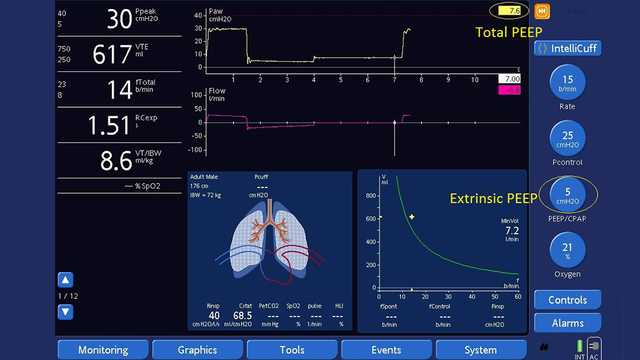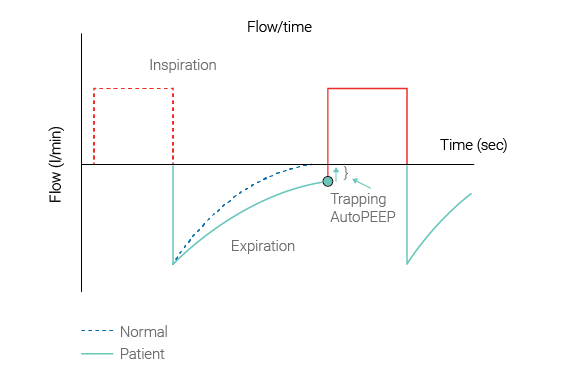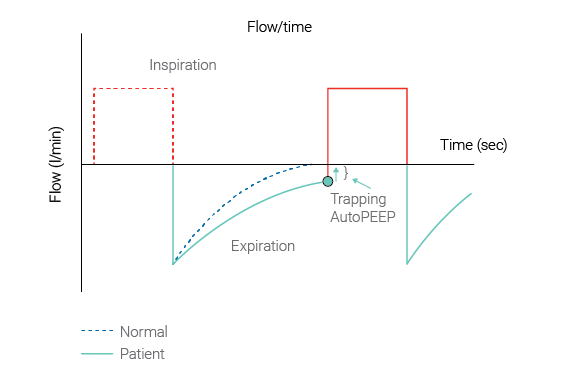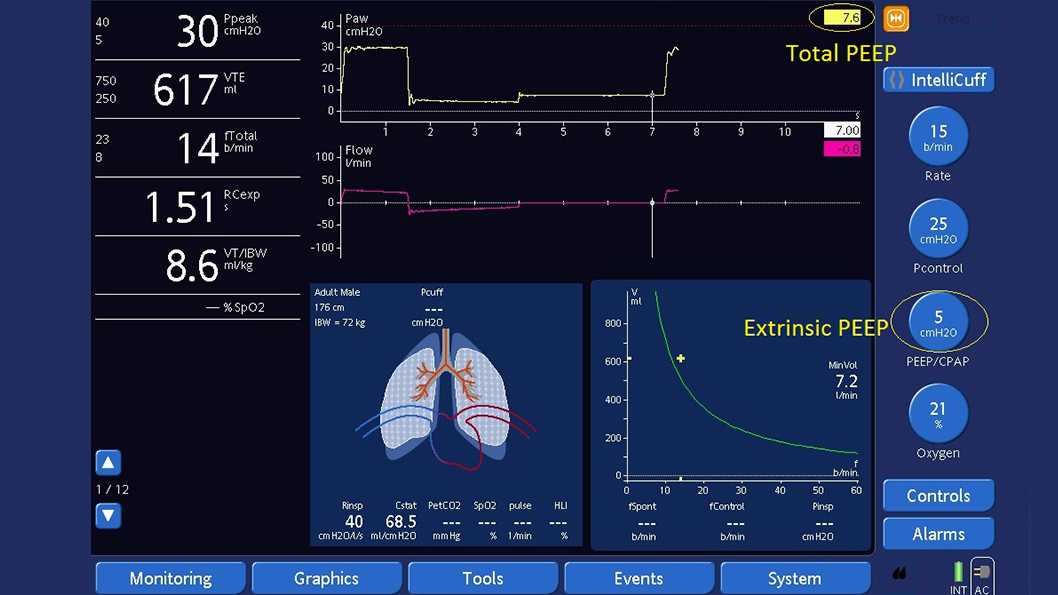
Autor: Clinical Experts Group, Hamilton Medical
Datum: 14.07.2017
Last change: 30.09.2020
(Originally published 14.07.2017) Previously: select Exp hold, when flow=0 select Exp hold again to deactivate hold maneuver. SW versions updated.Im Falle einer dynamischen Hyperinflation der Lunge übersteigt der durchschnittliche endexspiratorische Druck in den Alveolen (also der tatsächliche gesamte PEEP (PEEPtot)) den durch das Beatmungsgerät angewendeten PEEP‑Wert (PEEPe). Die Differenz zwischen PEEPtot und PEEPe entspricht dem intrinsischen PEEP (PEEPi); sie wird auch AutoPEEP genannt (1).

AutoPEEP und RCexsp
AutoPEEP wird auch als Airtrapping, Breath Stacking, dynamische Hyperinflation, unbeabsichtigter PEEP oder versteckter PEEP bezeichnet.
AutoPEEP ist ein bekanntes Phänomen bei maschinell beatmeten Patienten mit langen exspiratorischen Zeitkonstanten (RCexsp), z. B. bei Patienten mit chronischer obstruktiver Lungenerkrankung (COPD) oder akutem starkem Asthma.
WICHTIG: Der resultierende AutoPEEP‑Wert ist nicht auf der Kurve für den Atemwegsdruck sichtbar, die während der normalen Verabreichung des Atemhubs auf dem Bildschirm des Beatmungsgerätes angezeigt wird.
(Abbildung 1 unten: Quelle Garcia Vicente et al. (

Auswirkungen von AutoPEEP
AutoPEEP ist der Grund für die Veranlagung eines Patienten zu erhöhter Atemarbeit, Barotrauma, hämodynamischer Instabilität und Schwierigkeiten bei der Triggerung des Beatmungsgerätes. Wenn die hämodynamischen Auswirkungen von AutoPEEP nicht erkannt werden, kann dies zu einer unangemessenen Beschränkung der Flüssigkeiten oder einer nicht notwendigen Therapie mit Vasopressoren führen. AutoPEEP kann die Entwöhnung von der maschinellen Beatmung behindern.
Pflegekräfte sollten auf das Auftreten von AutoPEEP während der Beatmung achten und die Parameter zur Beatmungskontrolle entsprechend einstellen, um die negativen Auswirkungen von PEEP zu vermeiden.
AutoPEEP berechnen
Alle Beatmungsgeräte von Hamilton Medical sind mit der einzigartigen Fähigkeit ausgestattet, AutoPEEP als Monitoring‑Parameter Atemhub für Atemhub anzuzeigen. Er wird anhand der Methode der kleinsten Quadrate (LSF) über den gesamten Atemhub berechnet (
So messen Sie den gesamten PEEP mithilfe eines exspiratorischen Hold‑Manövers (siehe Abbildung 2 unten):
Stellen Sie sicher, dass die Paw‑Kurve angezeigt wird.
- Öffnen Sie das Fenster Hold.
- Warten Sie, bis die Anzeige der Paw‑Kurve an der linken Seite wieder gestartet wird.
- Warten Sie auf die nächste Inspiration.
- Wählen Sie dann Hold Exsp. Warten Sie 3 bis 5 Sekunden, wählen Sie dann Hold Exsp oder drücken Sie den Einstellknopf erneut, um das Hold‑Manöver zu deaktivieren, und schliessen Sie das Fenster.
- Nach dem Manöver wird das Fenster „Hold“ geschlossen und die Funktion „Einfrieren“ wird automatisch aktiviert.
- Ermitteln Sie den gesamten PEEP, indem Sie mit dem Cursor auf der Druckkurve die Punkte hinter der Stelle anzeigen, wo der Flow null erreicht hat.
- Berechnen Sie AutoPEEP, indem Sie den extrinsischen PEEP vom gesamten PEEP abziehen.
Berechnungen
| AutoPEEP | '= gesamter PEEP ‑ extrinsischer PEEP = intrinsischer PEEP |
|---|---|
| PEEP | '= extrinsischer PEEP und ist vorausgewählt |
| Gesamter PEEP | '= intrinsischer PEEP + extrinsischer PEEP |

Airtrapping vermeiden
Wenn ein unbeabsichtigter AutoPEEP vorhanden ist, sollten Pflegekräfte eine Anpassung der Kontrollparameter erwägen, um durch eine Erhöhung der Exspirationszeit Airtrapping zu vermeiden. Die Verwendung von Endotrachealtuben mit grossem Durchmesser oder von Bronchodilatatoren, eine kurze Einstellung für die Inspirationszeit bzw. eine lange Einstellung für die Exspirationszeit, niedrigere Atemfrequenzen und der Einsatz von Beruhigungsmitteln können nötig sein, um eine dynamische Hyperinflation aufgrund von Airtrapping zu vermeiden.
Jedes Beatmungsgerät von Hamilton Medical verfügt über den intelligenten Beatmungsmodus Adaptive Support Ventilation (ASV®). ASV verwendet automatisch Lungenschutzstrategien, um Komplikationen wie AutoPEEP zu vermindern.
Betroffene Geräte: HAMILTON‑G5/S1 (ab SW‑Version 2.8x); HAMILTON‑C3 (ab SW‑Version 2.0.x), HAMILTON‑C6 (ab SW‑Version 1.1.x)
Den vollständigen Quellenverweis finden Sie unten (
Fußnoten
Referenzen
- 1. Iotti, G., & Braschi, A. (1999). Measurements of respiratory mechanics during mechanical ventilation. Rhäzüns, Switzerland: Hamilton Medical Scientific Library.
- 2. García Vicente E, Sandoval Almengor JC, Díaz Caballero LA, Salgado Campo JC. Ventilación mecánica invasiva en EPOC y asma [Invasive mechanical ventilation in COPD and asthma]. Med Intensiva. 2011;35(5):288‑298. doi:10.1016/j.medin.2010.11.004
- 3. Iotti GA, Braschi A, Brunner JX, et al. Respiratory mechanics by least squares fitting in mechanically ventilated patients: applications during paralysis and during pressure support ventilation. Intensive Care Med. 1995;21(5):406‑413. doi:10.1007/BF01707409




